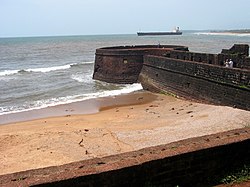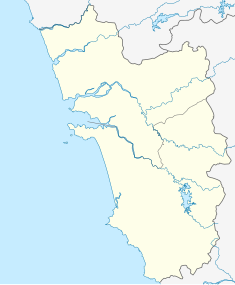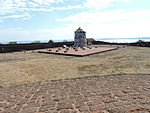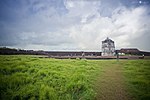Fort Aguada
This article needs additional citations for verification. (September 2021) |
| Fort Aguada | |
|---|---|
 Fort Aguada's ramparts overlook Sinquerim Beach and the Arabian Sea. | |
| Location | Goa, India |
| Coordinates | 15°29′17″N 73°45′47″E / 15.488°N 73.763°ECoordinates: 15°29′17″N 73°45′47″E / 15.488°N 73.763°E |
| Built | 1612 |
Fort Aguada is a well-preserved seventeenth-century Portuguese fort, along with a lighthouse, standing in Goa, India, on Sinquerim Beach, overlooking the Arabian Sea. It is an ASI protected Monument of National Importance in Goa.
Origins and history[edit]
The fort was originally constructed in 1612 to guard against the Dutch. It was a reference point for the vessels coming from Europe at that time. This old Portuguese fort stands on the beach south of Candolim, at the shore of the Mandovi River. It was initially tasked with defense of shipping and the nearby Bardez sub-district.
A freshwater spring within the fort provided water supply to the ships that used to stop by. This is how the fort got its name: Aguada, meaning watery in the Portuguese language. Crews of passing ships would often visit to replenish their freshwater stores. The Aguada Fort Lighthouse erected in 1864 is the oldest of its kind in Asia. Built in 1612, it was once the grandstand of 79 cannons. It has the capacity of storing 2,376,000 gallons of water, one of the biggest freshwater storage of the time in whole of Asia. This fort is divided in two segments: the upper part acted as fort and watering station, while the lower part served as a safe berth for Portuguese ships. Whereas the upper part has a moat, underground water storage chamber, gunpowder room, lighthouse, and bastions, it also has a secret escape passage to use during time of war and emergency. The lighthouse at the initial stage is used to emit light once in 7 minutes.
Fort Aguada was the most prized and crucial fort of Portuguese. The fort is so large that it envelops the entire peninsula at the southwestern tip of Bardez. Built on the mouth of Mandovi River, it was strategically located and was the chief defense of Portuguese against the Dutch.[1]
During the Salazar Administration, Fort Aguada was repurposed for use as a prison primarily, some claim, for Salazar's political opponents.[citation needed]
Aguada lighthouse[edit]
The Aguada lighthouse was built in 1864 on a hill located on the west to the fort. It is one of the oldest in Asia. It is located between Mormugao peninsula and Calangute beach. It was replaced by a new lighthouse in 1976 after serving for about a century. There was a large bell on the lighthouse which was found in the ruins of Saint Augustus monastery in Old Goa.[1]
Aguada Central Jail[edit]
Aguada Central Jail is a part of the fort and which was the largest prison in Goa till 2015. The 17th-century Portuguese-era structure has been renovated by the Goa Tourism Development Corporation along with the Goa Heritage Action Group and Goa's freedom fighters and opened for tourists as a Freedom Struggle Museum to showcase Goa's freedom struggle and be a true tribute to the heroic deeds and glorious sacrifices of all those who took part in Goa's Liberation and who fought against the British rule for the freedom of India and were jailed there. It was inaugurated on December 19, 2021 by PM Narendra Modi. The redevelopment cost approximately Rs 22 crore under the Centre's Swadesh Darshan Scheme. This museum has two particular cells dedicated to liberation fighters T B Cunha and Ram Manohar Lohia, where they were imprisoned under the Portuguese regime.[2][3][4][5][6]
Taj Fort Aguada Resort[edit]
Taj Fort Aguada Resort formerly Fort Aguada Beach Resort is part of Taj Hotel Group. The hotel opened in 1974 at the site of the historic Portuguese Fort Aguada.[7]
Gallery[edit]
- Fort Aguada Pictures
References[edit]
- ↑ 1.0 1.1 Navy, Indian (1989). Maritime Heritage of India. Notion Press. ISBN 978-93-5206-917-0.
- ↑ "Goa's Aguada Jail to become a tourist hotspot post renovation in March 2021". The Times of India. Goa. 6 January 2021. Retrieved 20 December 2021.
- ↑ "Goa Unlocked: Aguada Jail To Become Tourist Attraction By March". Outlook (Indian magazine). 6 January 2021. Retrieved 20 December 2021.
- ↑ "This jail in Goa is set to become famous, and you won't believe why!". India Today. 18 May 2016. Retrieved 20 December 2021.
- ↑ Biswas, Sayantani (19 December 2021). "Goa: PM arrives to inaugurate multiple development projects on Liberation Day". Mint. Panaji. Retrieved 20 December 2021.
- ↑ "PM likely to open Aguada museum on December 19". The Times of India. Calangute. 13 September 2021. Retrieved 20 December 2021.
- ↑ "Taj Fort Aguada Beach Resort & Spa gets new General Manager".
External links[edit]
- Fort Aguada - spherical panorama 360°.
- Articles with unsourced statements from February 2008
- Forts in Goa
- Portuguese forts in India
- Lighthouses in India
- Colonial Goa
- 17th-century forts in India
- 1612 establishments in India
- 1610s establishments in Portuguese India
- Buildings and structures completed in 1612
- Tourist attractions in North Goa district
- Buildings and structures in North Goa district



















